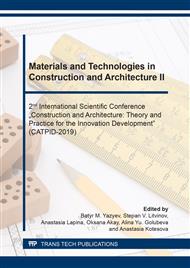p.181
p.187
p.195
p.201
p.206
p.211
p.217
p.224
p.231
Technological Peculiarities of Non Autoclaved Foam Concrete Production on the Base of Volcanic Pumice Aggregates
Abstract:
Armenia is known for its large reserves of various volcanogenic tuff, pumice and slag natural porous active rocks, which due to their favorable technical properties are also interesting from the point of view of using as aggregates for foam concretes. In this research first of all the types of volcanic pumice rocks having the greatest activity and porosity are considered. At the same time, a relatively dense and chemically active lithoidal variety of pumice was used as a fine, and a highly porous Ani type pumice as a coarse aggregate. The use of coarse aggregates is unacceptable in foam concretes, but in this case, taking into account that the Ani type pumice has an average density of 350-500 kg/m2, which is equivalent with foam concrete, it was decided to test as a coarse aggregate in the form of grains up to 20 mm in size. With proper dose selection, along with a positive reinforcement effect and reduction of shrinkable deformations, it will simultaneously reduce the cost of concrete by reducing the consumption of the most valuable cement component. Experience has shown that existing methods for foam concrete mixture production are not acceptable for such concretes, therefore, in order to prevent high quantity of water absorption and weighting of highly porous coarse aggregates, resulting in foam suppression and other negative consequences, there was a need to develop foam concrete mixture technology, which is presented in this research.
Info:
Periodical:
Pages:
206-210
Citation:
Online since:
December 2019
Authors:
Price:
Сopyright:
© 2020 Trans Tech Publications Ltd. All Rights Reserved
Share:
Citation:


